If you’re deep in the world of SEO, you probably know Google has rolled out some big updates recently.
But if not, you might have missed their recent Helpful Content Update.
Many sites have lost a lot of traffic since the update.
Many of the sites who were affected are websites primarily focused on publishing loads of content, but plenty of business websites have been impacted as well.
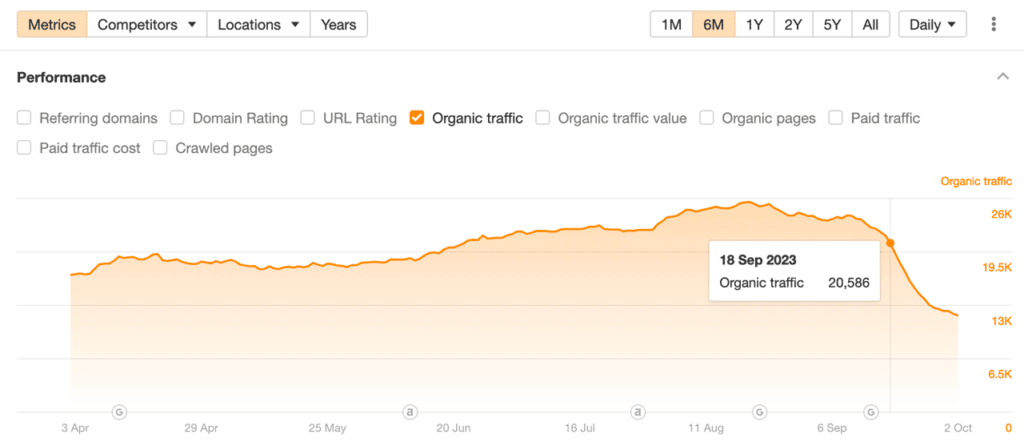
Traffic drop for regional business in the medical industry
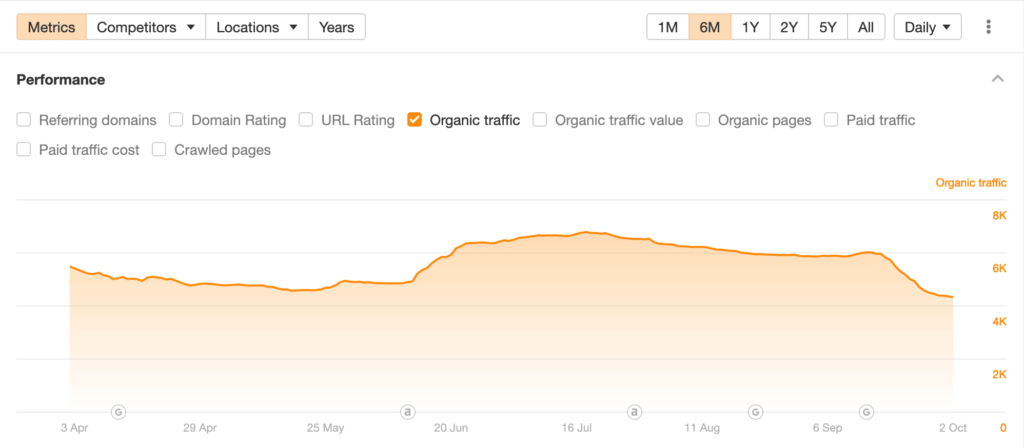
Traffic drop for regional site in the interior design space
This update, aimed at prioritizing truly helpful and original content, brings forth fresh challenges and opportunities for websites who publish a lot of content. In this article, we’ll delve deep into the nuances of this update, its implications, and strategies to thrive in this new “Helpful Content Era.”
Google’s Helpful Content System Explained
Google’s quest for user-centric search results has birthed the Helpful Content System, which fueled their Helpful Content Update.
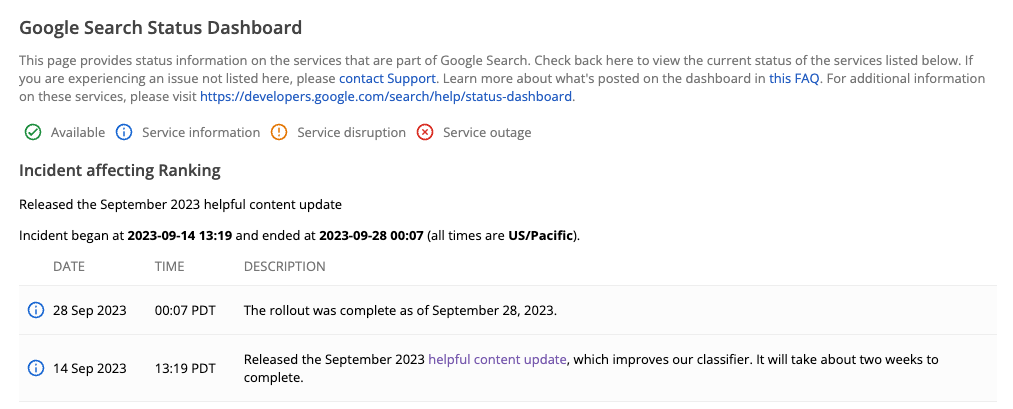
Google announces their September Helpful Content Update
It helps ensure users find truly valuable content when they search. Here’s a brief overview of how the system functions:
- Automated Analysis: This system utilizes a machine-learning model that operates across all languages. In simple terms, the analysis of sites and content to determine their helpfulness is done algorithmically – not manually.
- Quality Evaluation: The system identifies content with little or no added value, pushing it lower in search results.
- Site-wide Classification: The system classifies whole sites, meaning a site that has a lot of “unhelpful” content will feel the impact across their whole site, not isolated only to the posts that weren’t deemed helpful.
- User Satisfaction: The helpful content system prioritizes content that offers a genuinely satisfying experience to the user.
- Freshness: Google made it clear they can tell when you simply update the published date and change the year in the title to make a blog post appear “new and fresh.”
- Third-Party Content: Sites hosting unrelated third-party content could face negative implications, especially if it’s not aligned with the primary site’s purpose or lacks oversight.
One additional thing to note about the update is that Google is seemingly not taking issue with AI-generated content – as long as its reviewed, edited, and helpful to the intended reader.
How to Create Content in the Helpful Content Era
So in the Helpful Content Era, how does one ensure their content truly stands out? How can you make sure your site doesn’t get hit by the update, and ensure your content remains helpful in the eyes of Google for the long run?
Here are some fundamental principles to keep in mind:
Truly Valuable Content
The internet is a vast expanse of information on virtually any topic imaginable. To be deemed ‘helpful’, your content shouldn’t merely parrot what’s already out there or paraphrase commonly known information. Dive deeper into topics, present nuanced views, or provide detailed explanations. Think about the user’s intent behind a query and aim to satisfy that intent comprehensively.
If you’re only writing for something to be picked up and rank on search engines, it’s probably not all that valuable or helpful.

Rand Fishkin coined the term “10x Content” years ago, and encouraged people to write content that’s 10 times better than the next best thing online. Put effort into it. That advice still holds up today.
Make it Unique
It’s not enough to rephrase existing information. Aim for originality. This doesn’t necessarily mean presenting a never-before-seen idea. Instead, it could be offering a new perspective on a well-discussed topic or synthesizing information in a novel way.
Include First-hand Observations and Experiences
One of the most potent ways to add value is by including first-hand observations, experiences, or research. Personal anecdotes, case studies, or real-world data can provide insights that generic content lacks. It not only makes your content more relatable but also grounds it in reality, enhancing its trustworthiness.
Position Your Content Wisely
Before diving into content creation, research extensively. Understand what’s already out there, identify gaps, and aim to fill them. Perhaps there’s a question that hasn’t been answered satisfactorily, or a topic that hasn’t been explored from a particular angle. By positioning your content to fill these voids, you ensure it’s adding true value to the internet’s vast knowledge bank.
Engage and Adapt Over Time
Foster a community around your content. Engage with your readers, encourage feedback, and be open to evolving. Often, the audience will offer perspectives or raise questions that you hadn’t considered, providing opportunities to further enhance the helpfulness of your content.
By adhering to these principles, not only will your content resonate more with your audience, but it’ll also be in tune with the spirit of Google’s “Helpful Content System”, ensuring a symbiotic relationship where quality content gets the visibility it deserves.
8 Practical Tips for Creating Helpful and Valuable Content
Here are eight practical tips to ensure your content aligns with the ethos of Google’s Helpful Content System:
- Include Unique Perspective: Don’t just reiterate what’s already out there. Instead, approach topics from a fresh angle or provide a unique perspective that offers new insights.
- Use Concrete Examples: Whenever explaining a concept or idea, provide clear, relatable examples. This not only helps in better understanding but also adds depth to your content.
- First-Hand Accounts: Sharing personal experiences or first-hand accounts lends authenticity to your content. Whether it’s a product review, a travel blog, or a how-to guide, firsthand narratives resonate more with readers.
- Provide Additional Resources: Link to credible sources, studies, and further reading materials. This not only boosts your content’s reliability but also aids readers who wish to dive deeper into the topic.
- Engage with Multimedia: Incorporate images, infographics, and videos where relevant. Visual aids can enhance comprehension and keep readers engaged.
- Interactive Elements: Consider adding quizzes, polls, or interactive graphics. They can make the content more engaging and offer a more immersive experience to the user.
- Clear and Concise Writing: Avoid jargon and overly complex language. Your content should be easily digestible for all readers, irrespective of their prior knowledge on the topic.
- Continual Updates: In a fast-evolving digital world, information gets outdated quickly. Regularly review and update your content to ensure it remains current and valuable.
3 Helpful Content Examples from the Brew Blog
As an agency committed to valuable and helpful content, we produce a lot of it ourselves – on our own blog and for clients. Here are a few examples and what makes them so helpful.
Facebook Ads Cost: First-Hand Data + Interactive Elements
Last year, we wanted to post a blog letting our prospects and audience know how much it costs to advertise on Facebook. We considered just pulling data from a third party, but then we realized we have loads of client data on Facebook costs – it was a plenty large enough data set. So we compiled it ourselves and produced a report using unique, valuable, and first-party data.
The report was also interactive, adding a lot of value to the reader. They could filter and sort based on type of ad and industry.

Google wound up rewarding our efforts, and it ranks #1 for “how much do Facebook ads cost” in and around the Singapore area. It regularly brings in lots of traffic.

Salesforce Pipeline Guide: Step-by-Step Instructions
When producing “how-to” content, it’s vital you actually include instructions. Why would someone want to read your post if you just give broad, high-level insight when most of your readers probably need explicit direction?
We wrote a guide on setting up and using the pipeline feature in Salesforce.

We realized Salesforce had some instruction in help docs, but it wasn’t quite as concise as it could have been. So we went through and gave step-by-step instructions on setting up a pipeline, reporting, and analyzing it over time (using screenshots from within the tool).

Google loved it – it ranks well for a lot of terms related to the Salesforce pipeline, beating out much of Salesforce’s own content.
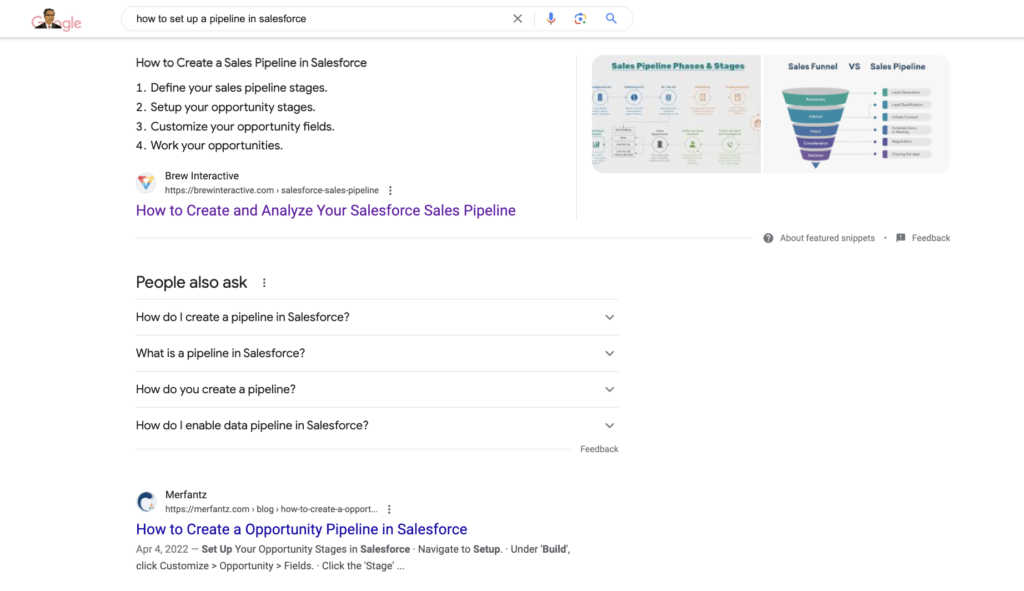
Marketing on WeChat: Including Case Studies + First-Hand Experiences
We recently wrote a blog about marketing on WeChat. It included an overview of the platform, tips for marketing, and then we added a section containing a WeChat case study where we walked readers through our exact methods for growing a brand on the platform.
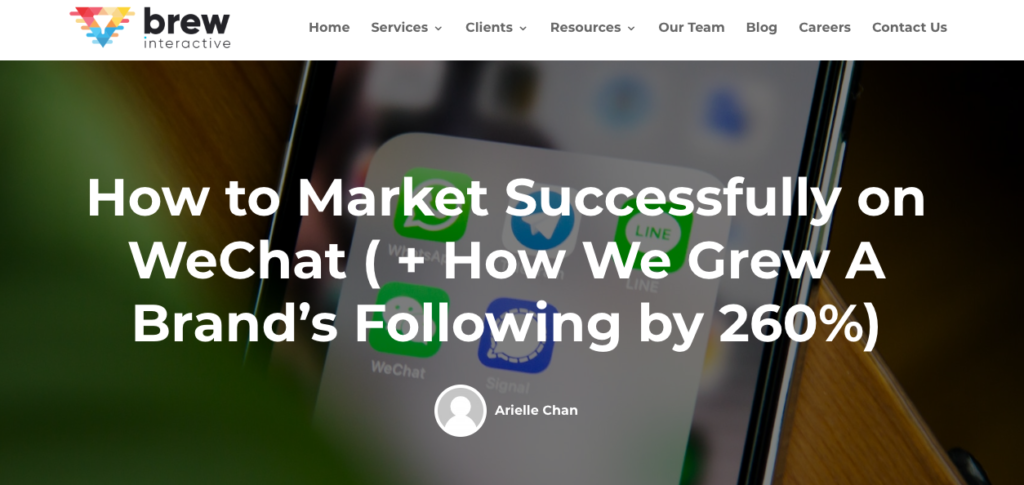

This content takes the leap from “here’s how you can do it,” to “here’s exactly how we did it.” It gives you credibility in your reader’s eyes and instills confidence in them – that’s as helpful as it gets.
Content Marketing in a Helpful Content World
As the digital landscape evolves, so do the benchmarks for quality content.
Google’s Helpful Content System underscores the importance of authenticity, value, and a focus on users. By embracing a content strategy that prioritizes unique insights, firsthand narratives, and continuous learning, creators can ensure their content remains not just algorithm-friendly, but genuinely impactful for readers.
In the end, the goal is simple: create content that informs, engages, and genuinely helps.
And if you don’t feel your team can do that, find a content marketing agency who can. Our team would love to help.





